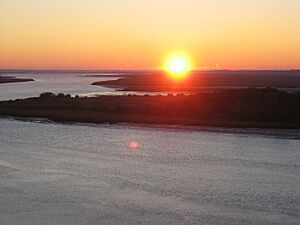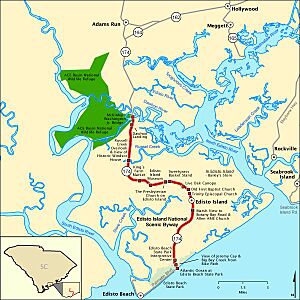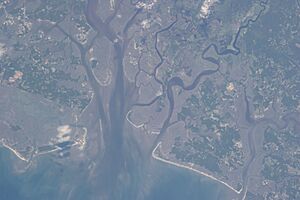Edisto Island facts for kids
Quick facts for kids
Edisto Island
|
|
|---|---|
 |
|
| Country | United States |
| State | South Carolina |
| County | Charleston |
| Area | |
| • Total | 67.8 sq mi (175.5 km2) |
| • Land | 67.6 sq mi (175.1 km2) |
| • Water | 0.2 sq mi (0.4 km2) |
| Elevation | 8 ft (3 m) |
| Population
(2000)
|
|
| • Total | 2,301 |
| Time zone | UTC-5 (Eastern (EST)) |
| • Summer (DST) | UTC-4 (EDT) |
| ZIP Code |
29438
|
| Area code(s) | 843 and 854 |
| GNIS feature ID | 1247638 |
Edisto Island is a beautiful island located in South Carolina. It's one of the famous Sea Islands along the coast. Most of the island is in Charleston County. A small part, including Edisto Beach, is in Colleton County.
The island, a nearby town, and the Edisto River are all named after the historic Edistow people. They were a Native American group. They lived on the island and traded with other tribes like the Catawba.
Contents
History of Edisto Island
Early Inhabitants and European Settlers
Long ago, Indigenous peoples often visited the islands. They used them for fishing during different seasons. The Edistow people lived on Edisto Island. They also lived in nearby mainland areas. Sadly, this group disappeared during the time of early European settlements.
The first European settlers on Edisto Island were English. They arrived in the late 1600s and early 1700s. Before that, the French and Spanish tried to settle here in the 1500s but didn't succeed. For a while, the island was called "Locke Island." This was after John Locke, an English philosopher.
Plantations and Crops
In the 1700s, people on Edisto Island grew rice. Later, they started harvesting timber and deerskins. They also grew indigo, a plant used for blue dye. They raised cattle for hides and meat.
After the American Revolution, cotton became the main crop. Edisto Island became famous for its special "Sea Island cotton." This cotton was very valuable. Hundreds of enslaved Africans were forced to work on these plantations. They created a unique culture and language called Gullah language in this area.
Edisto Island During the American Revolution
During the American Revolution, many British soldiers were on Edisto Island. After taking Savannah in 1788, the British moved into South Carolina. Beaufort became their main base. Many British troops stayed on Edisto Island. This happened before the British captured Charleston in 1780.
By 1790, the island had 223 white residents and 1,692 enslaved Black people. By 1860, there were 329 white residents and 5,082 enslaved people.
The Civil War on Edisto Island
In late 1861, many plantation owners left Edisto Island. Enslaved people began to escape and set up their own camps there. In January 1862, there were fights between armed settlers and Confederate soldiers. A Confederate attack killed unarmed settlers.
In February, Union soldiers came to the island. They used it as a base for future attacks on Charleston. They also protected the growing community of freed people. As Union forces took control, there were small battles. Confederate forces eventually left the island.
Most Union troops left in June for a battle called the Battle of Secessionville. By July, the remaining troops also left. The community of freed people moved to St. Helena Island. For the rest of the war, only a few escaped slaves and plantation owners remained. Near the end of the war, the island was again used for communities of freed slaves.
Reconstruction Era
From 1865 to 1877, agents from the Freedmen's Bureau mostly ran the island. Recently freed African-Americans also played a big role. Because of this, Edisto Island strongly supported the Republican Party.
The Ku Klux Klan caused terror in many parts of South Carolina. However, Edisto Island was mostly safe. Many United States Army troops were stationed there. Also, most of the people were African-American. The Klan decided it wasn't worth their effort there.
Preserving History
Since the 1900s, Edisto Island has become a popular place for tourists. Many resorts have been built. However, some private plantations still exist.
Many historic places on the island are listed on the National Register of Historic Places. These include old churches, plantation buildings, and other important sites. Some examples are the Edisto Island Baptist Church, Cassina Point, and Hutchinson House.
Geography and Nature
Edisto Island is about 26 miles (42 km) southwest of Charleston. It is home to Edisto Beach and the Wyndham Oceanridge resort.
Edisto Beach State Park is also on the island. It's a great place for day trips or camping. The park has a ranger station, clean bathrooms, a playground, and an education center. Many campsites are right on the beachfront, offering amazing ocean views. The park is shaded by beautiful trees with hanging moss. Each campsite has electricity, water, a fire pit, and a picnic table.
Island Population
According to the census from 2000, about 2,301 people lived on Edisto Island. There were 1,030 households, which are groups of people living together. The island had about 34 people per square mile.
The population was made up of different groups:
- 59.6% White
- 39.1% African American
- 0.20% Native American
- 0.6% from other races
- 0.5% from two or more races
- 1.4% of the population were Hispanic or Latino.
About 31.5% of households had children under 18. The average household had 2.55 people. The average family had 3.16 people.
The population was spread out by age:
- 27.0% were under 18
- 9.4% were 18 to 24
- 27.8% were 25 to 44
- 22.3% were 45 to 64
- 13.4% were 65 or older
The average age on the island was 36 years old.
Famous People from Edisto Island
- Kardea Brown: A cook and host of the TV show Delicious Miss Brown on Food Network. She films her show at her family's house on the island.
- James Jamerson: A famous bass guitar player. He was part of the Funk Brothers, who played on many Motown hit songs in the 1960s. He was born here.
- Jasper Johns: A well-known artist born in South Carolina in 1930. He bought a home and studio at Edisto Beach in 1961.
- Patti LuPone: A famous Broadway singer and actress. She has a winter home on the island.
- Emily Meggett: A leader in the Geechee-Gullah community, a chef, and an author.
- Lucia Murchison: A social worker born on Edisto Island. She was president of the South Carolina Public Health Association in 1965.
See also
 In Spanish: Edisto para niños
In Spanish: Edisto para niños




